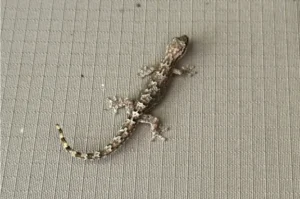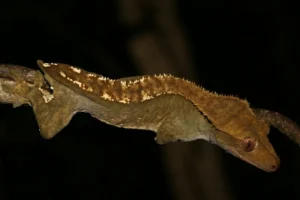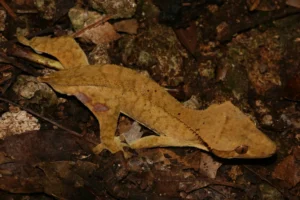You might have seen your gecko licking the glass walls of its tank or hiding in a damp corner and wondered, “What’s going on? Does it actually need moisture, or can it live fine in dry air?”
Yes, geckos need humidity, but how much depends on their species and natural habitat. Too little humidity can dry out their skin and cause shedding problems, while too much can lead to mold, breathing issues, and stress. Getting the balance right is really important.
Why Humidity Matters for Geckos
Humidity is just the amount of water in the air. Geckos rely on it more than most people realize.
In the wild, they live in places where the air has just the right amount of moisture, rainforests, deserts, rocky valleys, or tropical islands.
That moisture affects everything from how they breathe to how they shed their skin.

When the air is too dry, geckos can get dehydrated. Their skin might look dull, their eyes might seem sunken, and they could even stop eating.
Even though geckos don’t splash around like frogs, humidity is a key part of keeping them healthy and comfortable.
How Different Gecko Species Handle Humidity
Not all geckos come from the same environment. Some do well in dry desert air, while others need the constant moisture of a rainforest.
-
Leopard geckos (dry, rocky regions in Asia): prefer 30–40% humidity.
-
Crested geckos (humid forests in New Caledonia): need 50–70% humidity.
-
Tokay geckos (tropical climates): do best around 60–80% humidity.
-
Day geckos (Madagascar): prefer 50–70% humidity, with spikes after misting.
Basically, knowing where your gecko comes from tells you what kind of humidity it needs.
How Geckos Use Humidity to Stay Hydrated
Geckos don’t just drink from a water dish, they actually absorb some water from the air.

When humidity is right, tiny droplets collect on leaves, glass, or decorations. Geckos lick these droplets to hydrate. That’s why you often see them licking the walls, it’s completely normal.
This is especially true for crested or day geckos, which are used to dew and rainfall in their native forests.
What Happens When Humidity Is Too Low?
Low humidity is a common problem in indoor tanks. It can lead to:
-
Dehydration: the gecko may look thin, and skin might wrinkle.
-
Stuck shed: old skin doesn’t come off properly, especially around toes, tail tips, and eyes.
-
Breathing trouble: dry air can irritate their lungs.
-
Loss of appetite or energy: dehydrated geckos become weak and eat less.
Stuck shed is dangerous because it can cut off blood flow to toes or tail tips if not fixed.
You can prevent this by keeping humidity steady and offering a humid hide. This a small box with damp moss or paper towels where your gecko can rest while shedding.
What Happens When Humidity Is Too High?
Too much humidity can also be a problem.

Constant dampness encourages bacteria and mold, which irritates skin, causes infections, and can make it hard for geckos to breathe.
Signs of too much humidity include:
-
Condensation dripping inside the tank
-
A musty or wet smell
-
Gecko staying near the top or trying to escape
Desert species, like leopard geckos, are especially sensitive to damp air.
The goal is balance, just enough moisture to keep skin soft and help with shedding, but not so much that the tank feels swampy.
How To Measure and Control Humidity
The easiest way to check humidity is with a digital hygrometer. Place it in the middle of the tank, not too close to the heat source.
To control humidity:
-
Increase it: mist lightly once or twice a day.
-
Lower it: improve ventilation or use a fan nearby.
-
Maintain steady levels: add live plants, moss, or a moisture-holding substrate like coconut fiber.
For a humid hide, use a small box filled with damp sphagnum moss. It creates a perfect little spot for shedding and resting.
How Temperature and Humidity Work Together
Heat affects humidity. Warm air holds more moisture, cool air holds less.
If you mist heavily but the heat lamp is too strong, the water evaporates too fast. If the tank stays cool and damp all the time, mold can grow.
A warm side and a cool side in the tank lets your gecko pick the spot where both temperature and humidity feel right.
How Geckos Naturally Find Humidity
In the wild, geckos are great at finding tiny pockets of moisture.
-
Desert species hide in burrows or under rocks.
-
Tropical species hide under leaves or tree bark.
If it gets too dry, they move into these shelters until the humidity is comfortable again. Even in a tank, geckos follow this instinct; moving between dry and damp areas to stay hydrated and comfortable.
Crested Geckos vs. Leopard Geckos: Humidity Needs
Crested geckos come from tropical forests where humidity can hit 80% after rain.
They rest in shaded leaves during the day and hunt at night, licking dew from plants.

Without nightly misting or damp air, they may stop eating or shed poorly.
For them, humidity is part of a daily rhythm built into their biology.
Leopard geckos, in contrast, live in semi-deserts with mostly dry air. They find pockets of moisture underground to shed and keep skin soft.

For pet leopard geckos, a dry tank with one humid hide is enough, around 35–40% humidity elsewhere.
This mimics the mix of dry air and hidden damp spots they’d find in the wild.
Why Shedding Problems Often Mean Humidity Problems
If you see your gecko’s skin peeling in patches or sticking to toes, it usually means humidity is too low.
Healthy geckos shed in one smooth piece and often eat the shed skin afterward.
When humidity drops, skin dries and becomes stiff. Tiny bits can get stuck, cutting off circulation.
Raising humidity slightly or letting your gecko spend time in a humid hide usually fixes the next shed.
How To Mist the Tank the Right Way
Misting helps, but it has to be done properly:
-
Use a spray bottle with a fine mist, don’t soak the tank.
-
Mist once or twice a day, depending on species.
-
Spray plants, walls, and decorations, not directly on the gecko.
-
Let the tank dry a bit between mistings.
Too much water can make the floor slippery or cause mold. The goal is to mimic morning dew or evening rain.
How Humidity Affects Gecko Breathing
Humidity also affects how geckos breathe.
Too dry, and their airways can get irritated, leading to wheezing, sneezing, or mouth breathing.
Too damp, and bacteria or fungi can grow in their lungs, causing infections. Keeping humidity in the right range prevents both problems.
Can You Tell If Your Gecko Is Comfortable?
Yes. Watch its behavior:
-
Moves around normally
-
Sheds cleanly
-
Eyes are clear, skin is smooth
-
Licks moisture occasionally
If it stays in its humid hide all the time, the tank may be too dry. If it avoids the hide completely, it may be too damp.
Observing your gecko is one of the easiest ways to judge humidity.
Common Humidity Mistakes To Avoid
New keepers sometimes:
-
Mist too much
-
Forget ventilation
-
Place the tank near heaters or AC vents
-
Ignore species-specific humidity needs
These small mistakes can quickly stress a gecko or cause health problems.
The Role of Plants and Substrate
Live plants do more than look nice, they help regulate humidity naturally.
Plants release moisture slowly and absorb extra water from the soil. Substrates like coconut fiber, moss, or organic soil hold moisture without getting soggy.
Together, they help keep humidity stable and smooth.
Conclusion
So, do geckos need humidity? Absolutely, but how much depends on their origin.
A tropical gecko needs humid air every day, while a desert gecko just needs a damp hide for shedding.
Getting the balance right keeps your gecko healthy. Too dry, and shedding is hard. Too wet, and it risks infection.
When the humidity is right, your gecko’s colors pop, its skin stays smooth, and its movements are calm and confident.
The right humidity doesn’t just make your gecko comfortable, it helps it thrive.
Hi, my name is Ezra Mushala, i have been interested animals all my life. I am the main author and editor here at snakeinformer.com.

